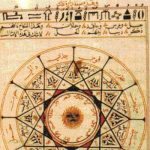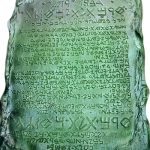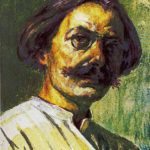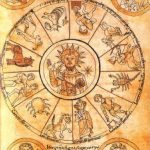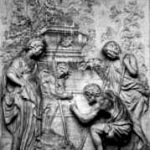Chapter Seven
Not long after the Gospels were written, an author who identified himself as John, perhaps the same as the Apostle John, son of Zebedee, recorded a vision he had while imprisoned on the island of Patmos in the Aegean Sea. John’s apocalyptic vision became the official and orthodox version of the end of the world mainly because of this identification with the beloved apostle of the Gospel of John. His revelation would become The Revelation as the apostolic church closed ranks against the Gnostics and the pagan Romans.
The early church had many different versions of the apocalypse, just as there were many different Gospels. A entire literature of prophetic apocalypses had developed since the time of Ezekiel and Daniel. Many of these texts, such as the Dead Sea scrolls, thought now to be the remnants of the Temple’s library, have only surfaced in the 20th century. From these sources, we can see that the early church, struggling toward some sort of unity, chose John’s vision as the authentic image of the end of the world.
Jewish Christianity did not survive the destruction of the Temple at Jerusalem in 70 CE. The Gospels, all written after this apocalyptic event, reflect a Christianity that had lost its local messianic roots and become instead a universal mystery religion. The three so-called Synoptic Gospels, Matthew, Mark and Luke, were all composed in response to the central question of who had authority within the movement. The answer of the Gospels is clear: only the apostles and their spiritual descendants could claim legitimate authority over the church.
Early in the second century we can detect the beginnings of orthodoxy. As the apostolic Gospels spread, an organization developed that included deacons to look after the people, priests to perform the ceremonies and bishops to administer the authority of the apostles in their absence. The chain of command was very clear and simple. God had sent Christ, who had called the apostles. To them, He gave the responsibility for His church, and they in turn ordained the leaders of the individual Christian communities.
However, the mystical aspects of Christianity had spread throughout the Empire, blending with various other currents, such as the essentially pagan beliefs of Gnosticism. This created a vast Christian movement that was far from content with the simple apostolic interpretation of spiritual authority. The Gnostics in particular insisted on a direct experience of Christ that was unmediated by any priest or bishop. This was of course much more exclusive and difficult to obtain than the apostolic guarantee of instant salvation conferred by belief and obedience.
Orthodox, apostolic Christianity became a mass movement in the late second century, while Gnostic groups dwindled into closed societies of adepts. Other salvationist religions, such as the Christian look-alike known as Mithraism, competed for adherents and Imperial support. By 180 CE, when Irenaeus complied his authoritative list of books in the New Testament canon, with St. John’s Revelation as its official apocalypse, orthodox Christianity had solidified into a powerful social and political force. For over a century, in the face of periodic persecutions from various Emperors, the orthodox church had gained in strength and influence. The extreme persecutions of the early fourth century were a last ditch attempt to halt the erosion of Imperial and pagan authority caused by the growth of Christianity with its appeal to God’s authority as administered by the apostolic bishops.
The Book of Revelation has the authority of the Apostle John, the beloved disciple who sat next to Christ at the Last Supper, behind it. In it, Christ speaks, through John, directly to the seven churches of Asia, lecturing and scolding the Christians while warning them of a coming period of persecution. And then, Christ invites John to “Come up here and I will show you what must take place after this.” John ascends to the throne of Heaven and sees the seraphim mentioned by Ezekiel. He also sees a Lamb, who breaks open the seven seals and reveals the future.
This long, complex and bizarre vision seems intended to encourage the faithful in their resistance to the pressures of Emperor worship. Some of the churches which Christ addresses through John were advocating a policy of compromise with the Roman authorities. This must be stopped, because the final showdown between God and Satan was imminent. Satan, in the form of the Roman state, will increase its persecution of believers, but they must stand fast, even in the face of death. They are sealed from any spiritual harm, though their bodies may suffer, and they will in any case be vindicated when Christ returns to destroy the wicked.
Rome is seen in Revelation as the great beast, the whore of Babylon and its Emperor as the Anti-Christ. When Christ returns as King of Kings, he will lead the heavenly host in battle against the Beast and the kings of the earth. Christ wins and then rules for a millennium, the only place in the New Testament where a thousand year reign of Christ is mentioned. After this, Satan re-emerges from his pit and challenges Christ. God sends fire from the sky and Satan, the beast and the false prophet all end up roasting in the lake of fire.
This ushers in the final day of judgment. After punishing the wicked and resurrecting the saints, God decides to dwell among men and therefore creates a new heaven and a new earth, along with a New Jerusalem. There is no visible Temple in this New Jerusalem and no need of the sun or the moon. The presence of God and Christ provide so much Light that it is never dark. From the middle of the new city flow the waters of the river of life, and on its bank stands the Tree of Life, which produces fruit continually. The elect will see the face of God and therefore be immortal, reigning “forever and forever.”
Clenthius, a Gnostic poet of the early second century, knew of John’s Revelation and wove it into his own work, now long lost except for disapproving quotes from Origen, on Chilaism. He gained a large following by teaching that the millennium foretold in John’s Revelation would be a physical earthly paradise where the senses “would be subject to delights and pleasures. . .There would be a space of 1000 years for celebrating nuptial festivals.”
Origen was the first important Christian to discredit the common notion of a physical paradise as the Kingdom of Heaven. He substituted a spiritual and individual kingdom for the literal and collective apocalypse described by John’s Revelation. Origen explained that the heavenly feasting prophesied in Revelation, and that so delighted the Chilaists, should be understood as spiritual nourishment from Christ.
But the idea of a physical New Jerusalem of gold and precious stones proved hard to displace. Chilaism would continue to crop up around the edges of orthodoxy for more than a thousand years. As we will see, the idea of a physical transformation that accompanies the end of the world would become the inner secret of all western occultism. In alchemy, the process of transformation would be studied in isolation from its Gnostic and Chialist origins. This fragmentation of the ancient knowledge led to many dead ends and vain quests. The timing of the transformation became more important than the transformation of time.
Even the Chilaists and other Gnostics agreed with Hippolytus, Bishop of Porto, who calculated the history of the world and found that Rome could only be the Empire of the Anti-Christ. He thought that his calculations proved that a century or so was left before the apocalypse. This was heralded as good news. The Christians had so far not been doing too well in their mission of converting the world. They felt they could use a bit more time before the End.
For the first two and a half centuries of Christianity’s existence, Imperial Rome had been the great enemy, the Government of the Evil King of the World, the Anti-Christ. And then, in the second decade of the fourth century, something very strange happened. A would-be King of the World won a battle outside the gates of Rome and attributed his victory to the power of Christ. The Battle of Mulvian Bridge made Constantine an Emperor, and with him, Christianity became the Imperial religion.
This sudden reversal must have seemed truly miraculous to the Christians themselves. The early years of the fourth century saw the worst Christian persecutions of the Roman era. Even Bishops of the Church had been forced to renounce their faith, and Christianity had begun to disappear in large portions of the eastern Empire. In the west, the persecutions had actually served to increase the number of Christians, and Constantine used this fact as a political tool. At Mulvian Bridge, his convenient espousal of Christianity was worth a dozen legions, he later remarked to Eusebius, his biographer.
Flavius Valerius Constantinus was an Imperial freebooter in the grand tradition of Julius Caesar and Octavius Augustus. Born the son of one of the four Imperial “Caesars” appointed by the last great pagan Emperor, Diocletian, Constantine plowed his way through the political intrigue that resulted from Diocletian’s abdication in 305 CE until, on the afternoon of October 27, 312 CE, Constantine trapped his last opponent, the Christian hating Maxentius, against the Tiber at Saxa Rubra (Red Rocks) with only one avenue of escape, over Mulvian Bridge.
In effect, this battle decided the fate of both the Empire and Christianity. The two had become inexplicably entwined on the afternoon before the battle, when Constantine had seen a vision. While positioning his legions for the next day’s battle, Constantine saw a great flaming cross in the sky with the Greek words en toutoi nika, “in this sign, victory.” That night, he dreamed that Christ appeared and commanded him to make the flaming cross his battle standard. Constantine awoke and called for his metalsmiths. He told them his dream and ordered them to prepare a new standard, one composed of the first two Greek letters of “Christ,” chi, an X and ro, a sort of crooked staff.
Under this new standard, the labarum, Constantine’s army drove Maxentius’ legions into the Tiber, where most of them, including Maxentius, died. Constantine entered Rome and was proclaimed the Emperor of the West. Gog, of Gog and Magog, the evil rulers of the world according to Hebrew eschatology, was now at least nominally a Christian.
Soon after his victory, in early 313, Constantine met with the eastern Emperor, Lucinius, at Milan and issued an edict confirming the religious toleration proclaimed by one of the earlier “Caesars” or tetrachs of Diocletian and expanded it to include all religions, even the Christians. This was the end of the great persecutions and the beginning of the meteoric rise in the fortunes of orthodox Christianity. By 323 CE, when Constantine had finally united by conquest both halves of the Empire and moved the capital to Byzantium, soon to become Constantinople, orthodox Christianity had become the official religion of the state.
Constantine, guided by his ambiguous vision, chose the winning side. It was the orthodox church’s insistence on obedience and conformity that appealed to Constantine. He needed a new form of universal religion with which to unify his vast Empire, and Orthodox Christianity filled the bill nicely.
But almost as soon as Constantine embraced orthodoxy, it was threatened by the most challenging heresy in the history of the Church. A pious and ascetic Egyptian priest by the name of Arius startled his bishop with his strange opinions about the nature of Christ. Arius argued that Christ could not be one with the Creator, but was rather the Logos, the first and best of all created beings. Since Christ had inhabited time, been born, lived and died, then he could not be co-eternal with God. A creation had occurred somewhere, and therefore Christ was not the same substance as His Father. The Holy Spirit, Arius insisted, was even less God than Christ, since it was a creation of Christ’s, and therefore twice removed from the substance of God.
Bishop Alexander called a council and excommunicated Arius and his followers. This created such wide spread religious turmoil that Constantine himself had to step in and settle it. In a letter to both parties, Constantine declared that the dispute was “trifling and unworthy of such fierce contests.” But the orthodox church did not see it that way. To them, the matter of consubstantiality versus similarity, a matter of an iota in the Greek words homoousia and homoiousia, was vital both politically and theologically. If Christ were not seen as God, the whole structure of the orthodox chain of command would crumble. And if anything happened to the unity of the Church, it destroyed its usefulness to the Imperial state. Settling this issue of an iota became a matter of life and death for the new Imperial orthodoxy.
Constantine resolved to end the dispute by calling the first ecumenical, or universal, church council at Nicaea in 325 CE. Constantine presided in person over the debates and according to Eusebius “moderated the violence of the contending parties.” Arius presented his view, but Athanasius, the hired theological gunslinger brought in by Bishop Alexander, made it absolutely clear that if Christ and the Holy Spirit were not considered the same substance as God, then polytheism would triumph. With that, the Bishops folded and agreed on a new universal creed that declared the trinity to be of one essence, that is, the same substance.
Unity was enforced by banishment and anathema. The orthodox Imperial church had embarked on its own pattern of persecution. All books by or about Arius were burned, and by Imperial decree, concealment of such a book was punishable by death. The Dark Ages had begun.
Constantine, the most nominal of Christians and a good candidate for the Anti-Christ, became instead the new Christ-model of the Catholic Orthodox Imperial Church, the Christos Pantocrater, Christ the Ruler of the Universe. The Demiurge had become the Messiah and a thousand and more years of spiritual oppression and persecution lay ahead. The End of the World had become an Institution of the Church.
More Articles from Sangraal.com:
Submit your review | |




